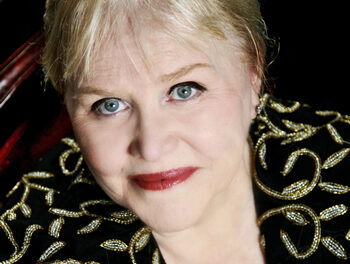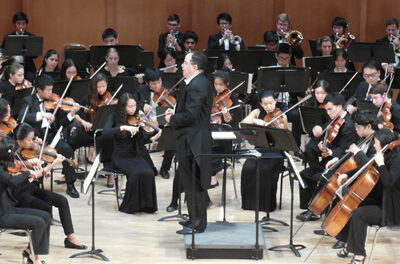Meira Warshauer: Living, Breathing Earth: Symphony No. 1, “Living Breathing Earth”; Tekeeya (a call), concerto for shofar & trombone; Haim Avitsur, shofar & trombone, Moravian Philharmonic, Petr Vronsky, cond.; Navona Records NV5842, ©2011, TT 52:00, $16.99.
Lest readers think that this is a sounds-of-nature as atmospheric background music CD, or something New Age-y, let me hasten to put such fears to rest! It is anything but…; it is 100% pure classical. The works are constructed following standard forms and the sounds are created with standard instruments, with heavy and creative reliance on the percussion section in the symphony; there’s no replay of sounds recorded in the wild involved. The concerto does, however, feature a horn from nature, a 4-foot long antelope’s that has no holes or valves; it is the first ever composed for this very ancient instrument that dates from Biblical times or earlier.
On first listening, the music brought to mind a host of pieces by a broad range of composers who have sought to evoke specific places with sounds. These would include Ferde Grofé, with his suites inspired by American landscapes such as Grand Canyon, Death Valley, Mississippi River, Hudson River, Niagara Falls, and others; Aaron Copland with his Red Pony and Tender Land; Bedřich Smetana’s Má Vlast; and Gustav Holst’s Planets, for example. Unfortunately, some of these have come, with the passage of time, to seem somewhat trite, but there is nothing trite or contrived about the sounds found here. It also brought to mind moments in music that suggest creation, both natural and artistic, such as Richard Strauss’ Also Sprach Zarathustra, whose first movement, “Sunrise,” was famously used in the 1968 movie 2001: A Space Odyssey, and Paul Hindemith’s Mathis der Mahler symphony. It is from these lineages that this music descends. The music is profoundly harmonious, if at times exotic; it occasionally seems to give a new meaning to the expression “music of the spheres.” But at the same time it is highly original, not falling neatly into any standard category or conventional school of composition.
Warshauer is Jewish and a native of Wilmington, NC; she now resides in Columbia, SC. Much of her music focuses on Jewish themes and rituals and sounds associated with them; Tekeeyah draws more heavily on these than does the symphony. Its movements are entitled: “A Call,” “Breaking Walls,” and “Dance of Truth”; they adhere to the classical concerto pattern of fast-slow-fast rhythms. To a certain extent, she handles the instrument and the themes in a fashion following the tradition of Bartók, Janáček, and Kodály, moving them from a regional and parochial context to a universal plane. She has characterized the symphony as a “love song to the earth;” it, too adheres to the form’s standard four-movement format. Its movements are entitled: “Call of the Cicadas,” “Tahuayo River at Night,” “Wings in Flight,” and “Living, Breathing Earth”; some were inspired by specific places Warshauer visited. It is also ‘program music’ in the sense that Warshauer has an agenda: she seeks to sensitize her listeners to the beauty of the planet and to its fragility in the hope that they will be motivated to both appreciate and protect it. The recording thus harmoniously joins two works that represent two of her vital personal concerns: her heritage and her passion for the environment, the world, its beauty and diversity. Yet at the same time it transcends such concrete categories to rise into a universal, transcendental, pantheistic realm.
The booklet contains notes by the composer written for the premières of the works (See below.) concerning her inspiration for each of their movements, and the details about the consortia of mostly NC & SC orchestras that commissioned them. To find the bios of the composer and the soloist, you are instructed to insert the CD into your computer, where you can also see the scores, videos of recording sessions, the composer at the piano, the soloist playing the shofar, additional photos of nature, and listen to an audio recording of SC cicadas, a 7.5-minute PRI Living on Earth feature profiling the symphony and its composition, and a 9.75-minute conversation between Avitsur, Warshauer, and Richard Kowal of WCQS Asheville Public Radio concerning the concerto – an additional informative and fascinating feast for the eyes and ears.
Live performances of both of these works were reviewed on CVNC, the symphony at its world première in February 2007, and Tekeeyah at its regional première in November 2009 and again in February 2011, the latter featuring the same soloist as in this recording. I refer readers to the detailed descriptions of the works offered by their writers and can heartily endorse their views concerning the beauty and value of the music. I can also heartily recommend your purchase of this CD. Warshauer’s is a unique and a wonderful – in the word’s multiple senses – voice.












